Automotive parts, machinery parts, tools and molds 'DLC Coating Application Case Studies'
Exhibiting at the Kansai Machine Element Technology Exhibition! Applicable to automotive mass production parts, machine components, and various tools and molds! A booklet full of case studies on DLC coating applications will be provided!
"DLC coating" is a surface treatment technology that possesses all the characteristics required for parts that need mechanical relative motion such as rotation, sliding, and reciprocation. It is effective in coatings for cutting tools, various molds, and automotive and machine parts. Japan ITF offers a variety of DLC coatings, including "HT" for automotive parts with excellent dry sliding properties, "F" for coatings on rubber and resin, and hydrogen-free DLC "HA" which is widely used for tools and molds. Currently, we are giving away a booklet that summarizes examples of applications and selection methods that clearly explain how to utilize DLC coatings! Just by reading it, you can understand the features and applications of DLC well. 【Features of DLC Coating】 ■ Hard and smooth ■ Low friction coefficient under non-lubricated conditions ■ Does not wear or damage the counterpart material during sliding (low counterpart aggressiveness) ■ Chemically inert and stable ⇒ does not cause seizure, adhesion, or welding ■ Not affected even in corrosive environments For more details, please request materials or view the PDF data available for download.
- Company:日本アイ・ティ・エフ
- Price:Other



![[Case Study on Problem Solving] Prevention of Unusual Noises Caused by Stick-Slip Phenomenon Between Resin and Metal](https://image.mono.ipros.com/public/product/image/731/2000774119/IPROS13597745058587052725.jpg?w=280&h=280)
![[Problem-Solving Case] Wear Resistance Measures for Aluminum Cylinders](https://image.mono.ipros.com/public/product/image/da9/2000774133/IPROS6844804369412558612.jpg?w=280&h=280)
![[Problem-Solving Case] Preventing Noise Caused by Friction Between Metal and Rubber Parts](https://image.mono.ipros.com/public/product/image/05f/2000774193/IPROS4324183772781058397.jpg?w=280&h=280)
![[Case Study on Problem Solving] Wear Resistance Between Molds in Resin Extrusion Molding](https://image.mono.ipros.com/public/product/image/fbd/2000774197/IPROS17654590068283039528.jpg?w=280&h=280)
![[Case Study] Improvement of Wear Resistance in the Mechanism of Heat Recovery System](https://image.mono.ipros.com/public/product/image/ab9/2000774211/IPROS15011040421530737610.jpg?w=280&h=280)
![[Problem-Solving Case] PVD Coating Case on Plating](https://image.mono.ipros.com/public/product/image/f96/2000801511/IPROS11000629147056385203.jpg?w=280&h=280)
![[Problem Solving Case] Extension of Mold Lifespan and Maintenance of High Dimensional Accuracy](https://image.mono.ipros.com/public/product/image/3cb/2000801515/IPROS2652090144789192472.jpg?w=280&h=280)
![[Problem Solving Case] I want to improve the release properties of rubber molds.](https://image.mono.ipros.com/public/product/image/8bc/2000801522/IPROS18039966899574785324.jpg?w=280&h=280)


